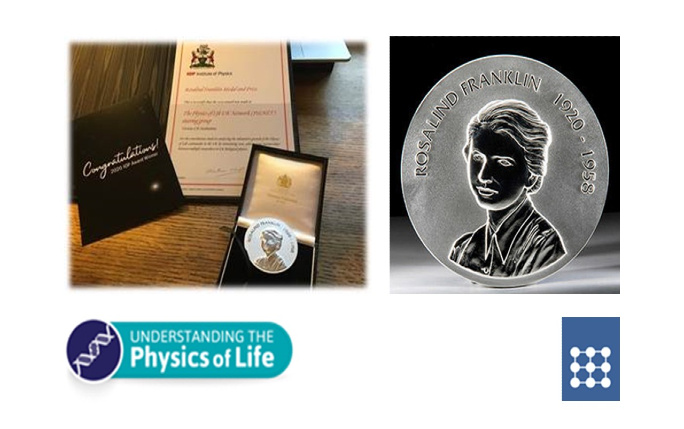Rosalind Franklin Medal and Prize

The Physics of Life Network Steering Group (PoLNET) [1] has been awarded the Institute of Physics Rosalind Franklin Medal and Prize, "For the contributions made to catalyzing the substantive growth of the Physics of Life community in the UK by stimulating new, adventurous partnerships between multiple researchers in UK biological physics". The Institute of Physics instituted the Rosalind Franklin Medal and Prize in 2008 "For distinguished contributions to physics applied to the life sciences including biological physics."
The Network arose from a Town Meeting called in 2012 by Athene Donald (Cambridge), Andrew Turberfield (Oxford) and Peter Weightman (Liverpool) to organise an application to the EPSRC to fund "A Grand Challenge on The Physics of Life." The network has been funded three times and has had a significant influence on the funding of research in bio and medical physics and in ensuring that interdisciplinary research is recognised in the Research Excellence Framework exercise. The Physics of Life become a priority topic for the UKRI Strategic, Research Fund in 2018 with a £ 15 m call for interdisciplinary research projects at the interface of physics and the life sciences. It is anticipated that a second funding call of similar scale will be announced in 2021, for grants starting in 2022.
You can become a member of the Physics of Life Network (its free) by signing up for our newsletter at https://www.physicsoflife.org.uk/contact-us.html. This will enable you to keep up to date with all the available funding opportunities. Follow us on Twitter! @PhysicsOfLifeUK
The Network Team are: Dr. Karis Baker (Durham University, also Network Co-ordinator), Professor Olwyn Byron (University of Glasgow), Professor Martin Cann (Durham University, also Co-chair), Dr. Susan Cox (Kings College London), Professor Athene Donald, FRS (University of Cambridge), Dr Simon Hanna (University of Bristol), Professor Jamie Hobbs (University of Sheffield), Professor Martin Howard (John Innes), Professor Rebecca Hoyle (University of Southampton), Professor Mark Leake (University of York), Professor Graham Leggett (University of Sheffield), Professor Cait MacPhee (University of Edinburgh), Dr. Euan MaGennis (Proctor and Gamble, Newcastle), Professor Tom McLeish, FRS (University of York, also Chair), Professor Stephen Smye (University of Leeds), Professor Andrew Turberfield (University of Oxford) and Professor Peter Weightman (University of Liverpool).
Rosalind Franklin was an English X-ray crystallographer whose work was critical to the understanding of the molecular structure of graphite, coal, viruses and DNA – the latter being recognised with Francis Crick, James Watson and Maurice Wilkins’s award of the Nobel Prize in Physiology or Medicine in 1962, four years after Franklin’s death.
The Long Citation for the award is set out below.
The ambitious goal of PoLNET has been to bring physicists and biologists together to develop a unified framework for understanding biology that integrates molecular and system levels of thinking into a unified whole.
A crucial component developed in particular by the team who have continuously served on PoLNET’s steering panel has been to stimulate physicists and biologists into genuine partnership through (i) respect by physicists for the complexity of biological problems, (ii) recognition by biologists that physicists can bring uniquely valuable insights, and (iii) recognition by physical scientists that great physics may start with a biological hypothesis.
A key feature of the individual team members has been their selfless efforts in organising a wide range of workshops, summer schools and plenary events for the benefit of the whole UK PoLNET community.
They have been responsible for devising, organizing and realizing workshops and plenaries in very diverse areas including: the living cell, synthetic biology, multicellularity, the physics of bacterial infection, forces in biology, life in extreme environments, the physics of cancer, information flow in biological systems, pattern formation and morphogenesis, nanostructures at soft interfaces, molecules mechanics medicines and more, as well as supporting other conferences of value to the biological physics community via multiple joint ventures with other networks and learned societies, such as Quantitative Gene Regulation and Interdisciplinary Challenges in Non-Equilibrium. These have fuelled new collaborations and grants.
An important part of the team’s work has been to develop younger researchers with both physical science and life science backgrounds through several exciting, well-received summer schools.
A testament to the team’s success has been the establishment of a £30m UKRI Strategic Priorities Fund for Building Collaborations at the Physics of Life Interface to support “internationally leading research that requires collaborative, interdisciplinary working to address key challenges at the interface of physics and the life sciences.” In short, the team has helped to enable not only the priming of new collaborations between physical and life scientists, but also to ensure that this exciting new work is properly resourced for the benefit of UK PLC.